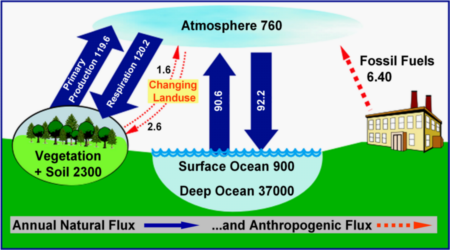1. Light and Life (5/8)
The carbon cycle and greenhouse effect
The carbon cycle is a series of processes through which carbon is exchanged. The cycle is usually thought of as four major reservoirs of carbon interconnected by pathways of exchange. The reservoirs are the atmosphere, the terrestrial biosphere (which usually includes freshwater systems and non-living organic material, such as soil carbon), the oceans (which includes dissolved inorganic carbon and living and non-living marine biota), and the sediments. The annual movements of carbon, the carbon exchanges between reservoirs, occur because of various chemical, physical, geological, and biological processes. The ocean contains the largest active pool of carbon near the surface of the Earth, but the deep ocean part of this pool does not rapidly exchange with the atmosphere.

When marine plants grow in the oceans and coastal zone, they use the energy from the solar light and the available carbon in the upper layers of the water. Most of this carbon in the water is replenished by uptake from the atmosphere. For the whole world the growth of small algae results in an uptake of 92 Pg Carbon per year.
Related SEOS links
- Worksheet: Atmospheric Carbon Dioxide and Global Temperature,
as html page or as printable rtf file - Worksheet: Carbon Budgets and Fluxes,
as html page or as printable rtf file
Dissolved organic matter (DOM)
When dead organic material decays in water, part of it is dissolved and forms a reservoir of nutrients and dissolved organic carbon (DOC).
The coloured fraction of DOC, called Coloured Dissolved Organic Matter (CDOM) or yellow substance, mainly absorbs blue light of the visible spectrum,
resulting in a brownish colour when we look at waters that
have much CDOM (peat bogs, some rivers, estuaries).
CDOM and Coastal Waters:
CDOM levels can vary both spatially and temporally. In coastal waters, CDOM can dominate the absorption of sunlight, particularly in the ultraviolet and blue regions of the spectrum. This CDOM comes mainly from the rivers that transport organic carbon from agricultural land, forests and sewers. Physical processes that promote vertical mixing of in the coastal ocean such as winter seasonal mixing (due to storms) can introduce CDOM to the surface. As sunlight intensity increases in spring and summer, the water at the ocean's surface warms making it less dense than water at depth, which is colder. This difference in density causes stratification between surface and deep ocean water, essentially forming a barrier that reduces the exchange of dissolved materials (including essential nutrients) between the surface and deeper water.
CDOM in water
